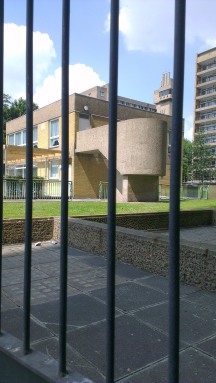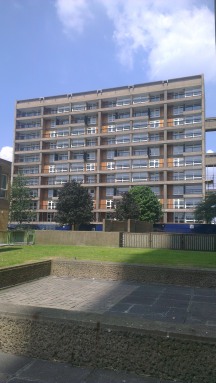I was lucky enough to spend a night/day in the Erno Goldfinger-designed and Grade II listed Balfron Tower last weekend. It is one of three housing blocks by Goldfinger on the Brownfield Estate in Poplar, East London, alongside Carradale and Glenkerry House.
Over the last few years an extensive renovation project has been taking place. Carradale House is currently empty with refurbishment nearly complete, while Balfron Tower is yet to be started. Residents are slowly moving out, temporarily or permanently depending on circumstance. Although, due to the nature of the wholesale refurbishment – including the renewal of kitchens, concrete cladding, bathrooms, essential services and access systems, there is no timescale for return. Inevitably, this means a uncertain future for current inhabitants. My educated guess, and it doesn’t take a genius to work this out, is that its part of wider, longer and ongoing process to ‘gentrify’ the East End. The proximity of the area to Canary Wharf means real estate values have increased since the 1980s. New Carradale House residents will undoubtedly want a slice of Brutalist chic – forcing up flat prices and disabling the return of previous tenants. A 30% social housing clause in Balfron Tower, as my friend alerted me to, still therefore permits 70% non-social housing.
As a result of this long moving-out process, the housing association responsible for its upkeep, Poplar HARCA, have facilitated a number of artistic and property guardian-type projects. Simon Terrill’s Balfron Project (2010) was one such enterprise, consisting of a number of visual renditions of the tower, including a stunning type C print of Balfron at night.
The friend we stayed with also had a number of fabulous postcards (update: by artist and resident Rab Harling) documenting the unique style and identity imposed by inhabitants on their own flat, providing a wonderful insight into the personal narratives the Tower has facilitated.
As a way to interpret the shifting geographies of housing and the ongoing gentrification of East London here’s an open-access introduction to the concept created by Tom Slater back in 2002. Tim Butler‘s article in the International Journal of Urban and Regional Research (subs. only) is centered on the differentiation between specific redevelopment processes, using the London Docklands as a case study – so it’s worth a read. This conceptual piece by Butler on gentrification over at Environment and Planning D (again, subs. only), also provides an argument for the continuing purchase of the term to critiquing the spatial dynamics of neoliberalism.
Update: Rab Harling will be a Leverhulme artist-in-residence at UCL’s Urban Lab for the next academic year (2013-2014). Read more here.









